A Detailed Report on Knowledge Management at Zendesk Company
VerifiedAdded on 2023/03/30
|15
|3976
|92
Report
AI Summary
This report provides a comprehensive analysis of Zendesk's knowledge management strategies. It begins with an introduction to Zendesk, its services, and its growth, followed by an overview of common knowledge management strategies. The core of the report examines the tools Zendesk employs, such as Canva, Instacart, and Evernote, and their approaches, including mapping knowledge areas, prioritizing speed over fidelity, and assigning ownership of knowledge chunks. The report then delves into a strategic and knowledge gap analysis, highlighting weaknesses in diversity, infrastructure investment in developing countries, and the personalization of customer experience through KM tools. It also covers Zendesk's operational and technological infrastructure, including the evolution of its data centers and the adoption of cloud technology. The report concludes by emphasizing the importance of AI-powered knowledge management and the ongoing development of the Zendesk Guide platform.
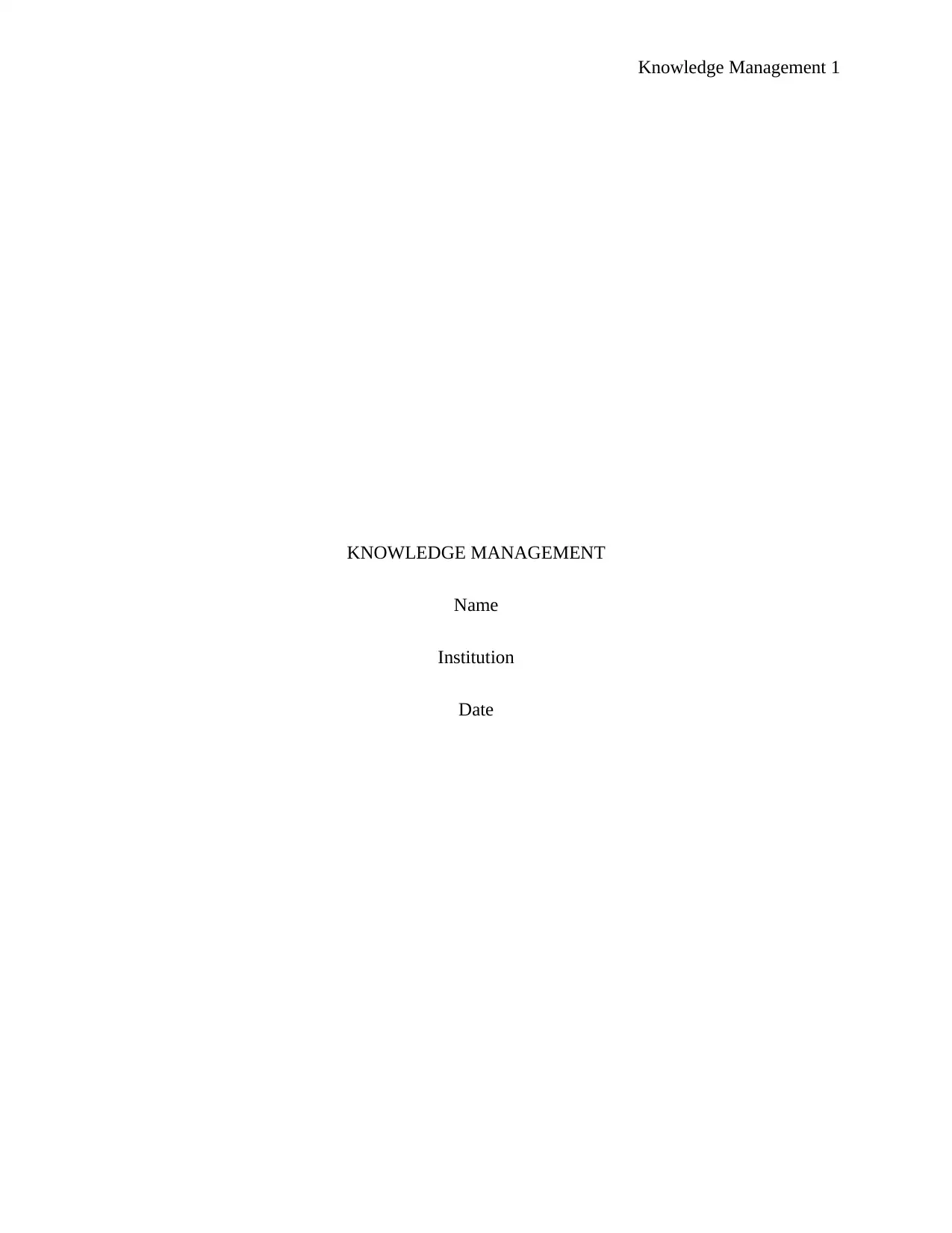
Knowledge Management 1
KNOWLEDGE MANAGEMENT
Name
Institution
Date
KNOWLEDGE MANAGEMENT
Name
Institution
Date
Paraphrase This Document
Need a fresh take? Get an instant paraphrase of this document with our AI Paraphraser
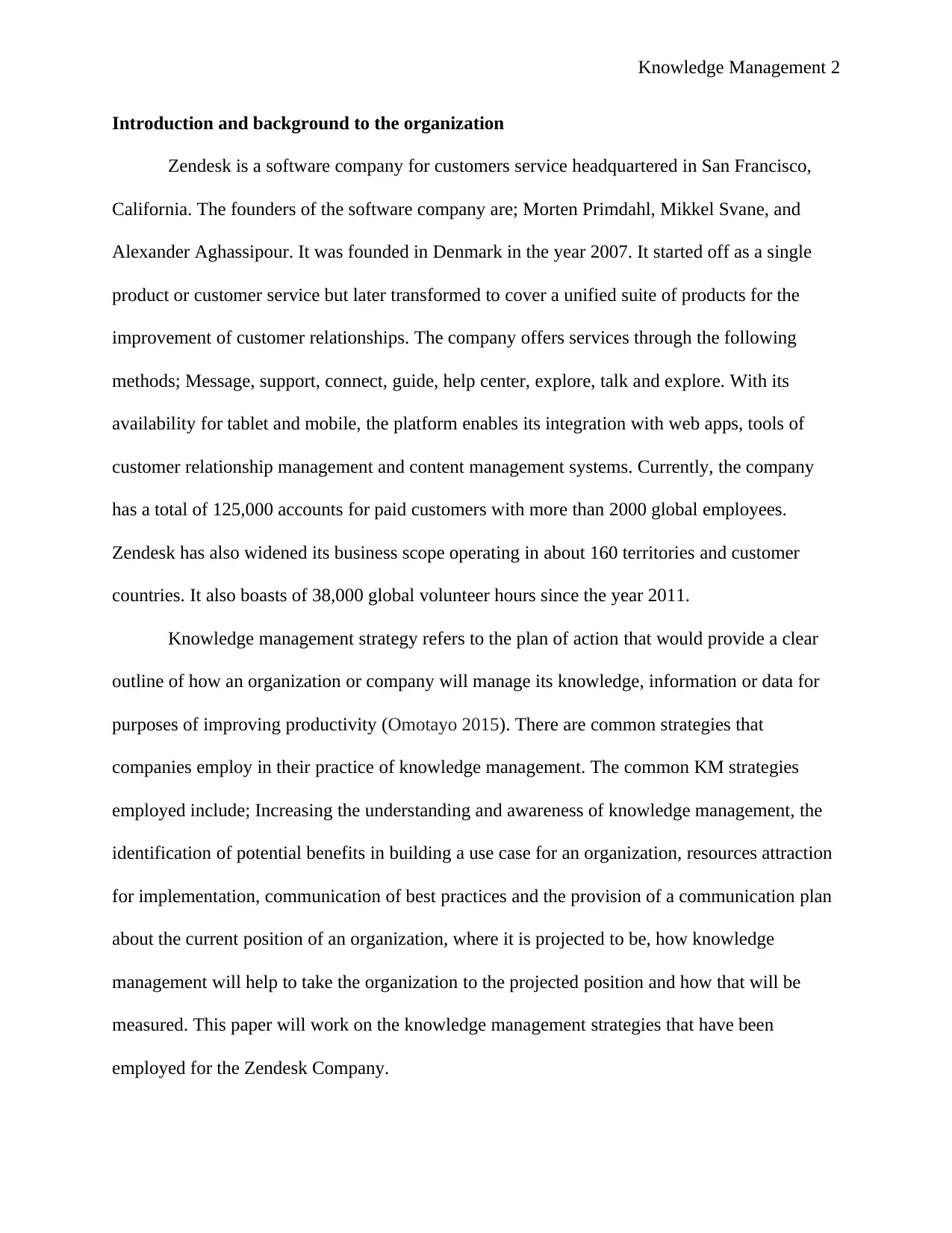
Knowledge Management 2
Introduction and background to the organization
Zendesk is a software company for customers service headquartered in San Francisco,
California. The founders of the software company are; Morten Primdahl, Mikkel Svane, and
Alexander Aghassipour. It was founded in Denmark in the year 2007. It started off as a single
product or customer service but later transformed to cover a unified suite of products for the
improvement of customer relationships. The company offers services through the following
methods; Message, support, connect, guide, help center, explore, talk and explore. With its
availability for tablet and mobile, the platform enables its integration with web apps, tools of
customer relationship management and content management systems. Currently, the company
has a total of 125,000 accounts for paid customers with more than 2000 global employees.
Zendesk has also widened its business scope operating in about 160 territories and customer
countries. It also boasts of 38,000 global volunteer hours since the year 2011.
Knowledge management strategy refers to the plan of action that would provide a clear
outline of how an organization or company will manage its knowledge, information or data for
purposes of improving productivity (Omotayo 2015). There are common strategies that
companies employ in their practice of knowledge management. The common KM strategies
employed include; Increasing the understanding and awareness of knowledge management, the
identification of potential benefits in building a use case for an organization, resources attraction
for implementation, communication of best practices and the provision of a communication plan
about the current position of an organization, where it is projected to be, how knowledge
management will help to take the organization to the projected position and how that will be
measured. This paper will work on the knowledge management strategies that have been
employed for the Zendesk Company.
Introduction and background to the organization
Zendesk is a software company for customers service headquartered in San Francisco,
California. The founders of the software company are; Morten Primdahl, Mikkel Svane, and
Alexander Aghassipour. It was founded in Denmark in the year 2007. It started off as a single
product or customer service but later transformed to cover a unified suite of products for the
improvement of customer relationships. The company offers services through the following
methods; Message, support, connect, guide, help center, explore, talk and explore. With its
availability for tablet and mobile, the platform enables its integration with web apps, tools of
customer relationship management and content management systems. Currently, the company
has a total of 125,000 accounts for paid customers with more than 2000 global employees.
Zendesk has also widened its business scope operating in about 160 territories and customer
countries. It also boasts of 38,000 global volunteer hours since the year 2011.
Knowledge management strategy refers to the plan of action that would provide a clear
outline of how an organization or company will manage its knowledge, information or data for
purposes of improving productivity (Omotayo 2015). There are common strategies that
companies employ in their practice of knowledge management. The common KM strategies
employed include; Increasing the understanding and awareness of knowledge management, the
identification of potential benefits in building a use case for an organization, resources attraction
for implementation, communication of best practices and the provision of a communication plan
about the current position of an organization, where it is projected to be, how knowledge
management will help to take the organization to the projected position and how that will be
measured. This paper will work on the knowledge management strategies that have been
employed for the Zendesk Company.
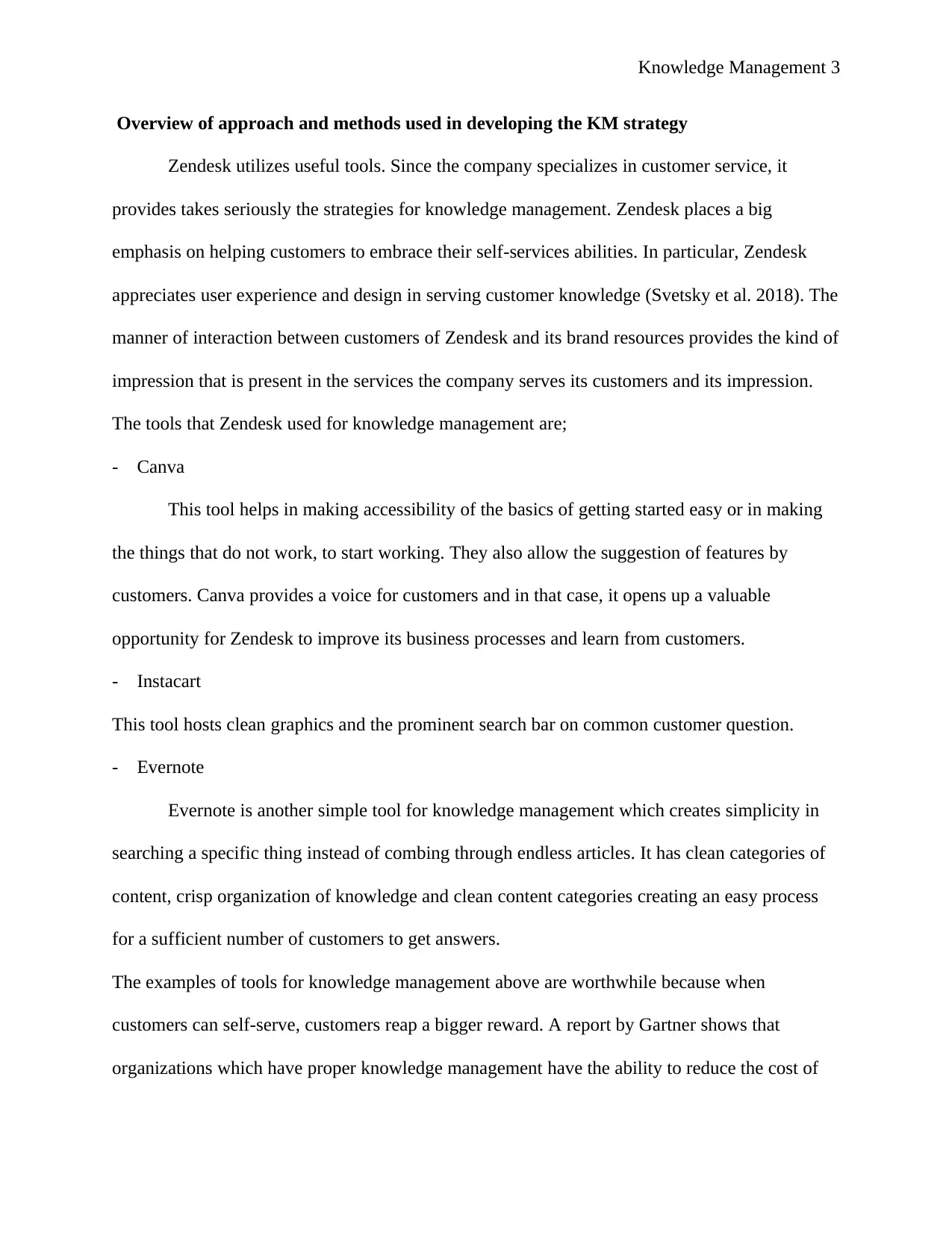
Knowledge Management 3
Overview of approach and methods used in developing the KM strategy
Zendesk utilizes useful tools. Since the company specializes in customer service, it
provides takes seriously the strategies for knowledge management. Zendesk places a big
emphasis on helping customers to embrace their self-services abilities. In particular, Zendesk
appreciates user experience and design in serving customer knowledge (Svetsky et al. 2018). The
manner of interaction between customers of Zendesk and its brand resources provides the kind of
impression that is present in the services the company serves its customers and its impression.
The tools that Zendesk used for knowledge management are;
- Canva
This tool helps in making accessibility of the basics of getting started easy or in making
the things that do not work, to start working. They also allow the suggestion of features by
customers. Canva provides a voice for customers and in that case, it opens up a valuable
opportunity for Zendesk to improve its business processes and learn from customers.
- Instacart
This tool hosts clean graphics and the prominent search bar on common customer question.
- Evernote
Evernote is another simple tool for knowledge management which creates simplicity in
searching a specific thing instead of combing through endless articles. It has clean categories of
content, crisp organization of knowledge and clean content categories creating an easy process
for a sufficient number of customers to get answers.
The examples of tools for knowledge management above are worthwhile because when
customers can self-serve, customers reap a bigger reward. A report by Gartner shows that
organizations which have proper knowledge management have the ability to reduce the cost of
Overview of approach and methods used in developing the KM strategy
Zendesk utilizes useful tools. Since the company specializes in customer service, it
provides takes seriously the strategies for knowledge management. Zendesk places a big
emphasis on helping customers to embrace their self-services abilities. In particular, Zendesk
appreciates user experience and design in serving customer knowledge (Svetsky et al. 2018). The
manner of interaction between customers of Zendesk and its brand resources provides the kind of
impression that is present in the services the company serves its customers and its impression.
The tools that Zendesk used for knowledge management are;
- Canva
This tool helps in making accessibility of the basics of getting started easy or in making
the things that do not work, to start working. They also allow the suggestion of features by
customers. Canva provides a voice for customers and in that case, it opens up a valuable
opportunity for Zendesk to improve its business processes and learn from customers.
- Instacart
This tool hosts clean graphics and the prominent search bar on common customer question.
- Evernote
Evernote is another simple tool for knowledge management which creates simplicity in
searching a specific thing instead of combing through endless articles. It has clean categories of
content, crisp organization of knowledge and clean content categories creating an easy process
for a sufficient number of customers to get answers.
The examples of tools for knowledge management above are worthwhile because when
customers can self-serve, customers reap a bigger reward. A report by Gartner shows that
organizations which have proper knowledge management have the ability to reduce the cost of
⊘ This is a preview!⊘
Do you want full access?
Subscribe today to unlock all pages.

Trusted by 1+ million students worldwide
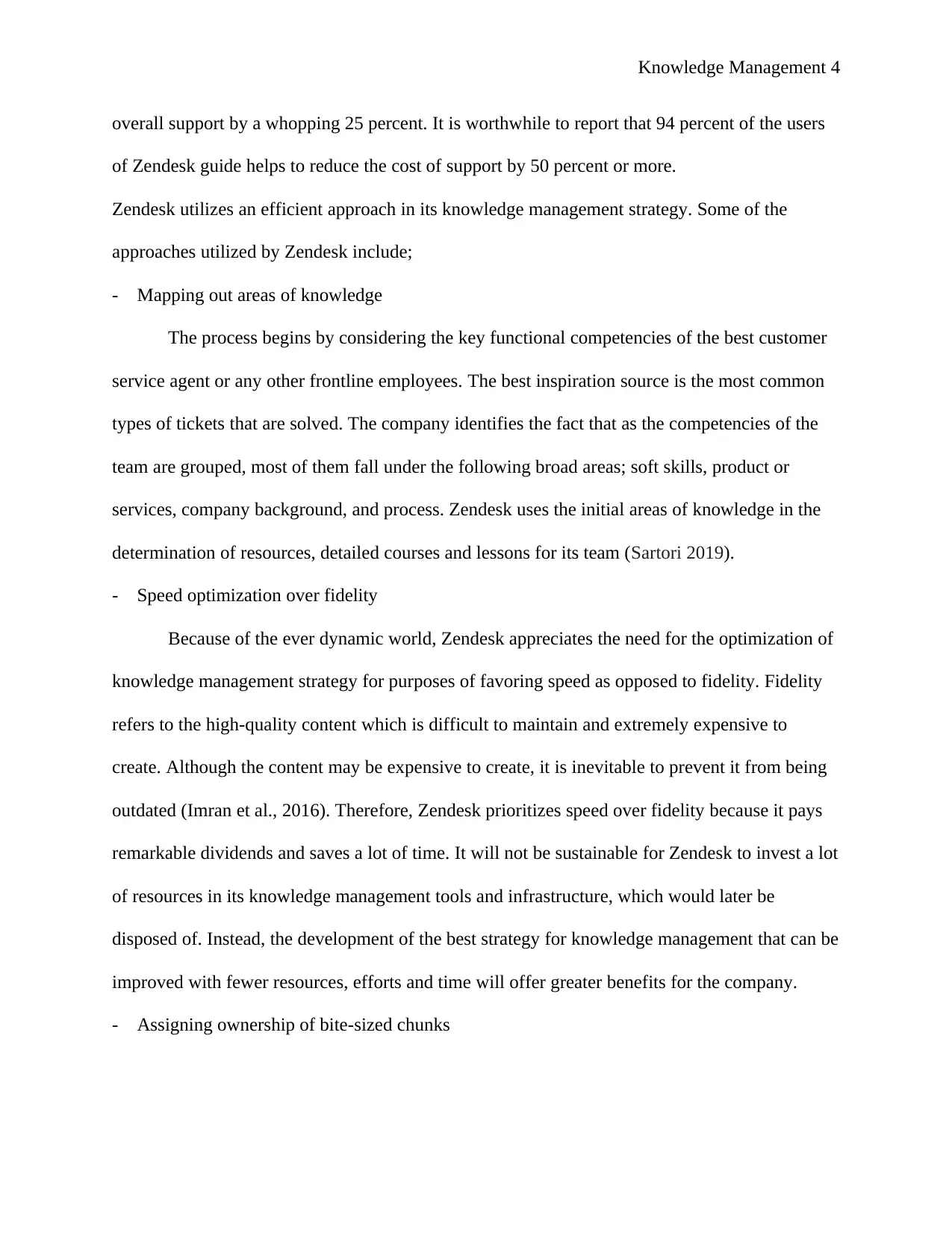
Knowledge Management 4
overall support by a whopping 25 percent. It is worthwhile to report that 94 percent of the users
of Zendesk guide helps to reduce the cost of support by 50 percent or more.
Zendesk utilizes an efficient approach in its knowledge management strategy. Some of the
approaches utilized by Zendesk include;
- Mapping out areas of knowledge
The process begins by considering the key functional competencies of the best customer
service agent or any other frontline employees. The best inspiration source is the most common
types of tickets that are solved. The company identifies the fact that as the competencies of the
team are grouped, most of them fall under the following broad areas; soft skills, product or
services, company background, and process. Zendesk uses the initial areas of knowledge in the
determination of resources, detailed courses and lessons for its team (Sartori 2019).
- Speed optimization over fidelity
Because of the ever dynamic world, Zendesk appreciates the need for the optimization of
knowledge management strategy for purposes of favoring speed as opposed to fidelity. Fidelity
refers to the high-quality content which is difficult to maintain and extremely expensive to
create. Although the content may be expensive to create, it is inevitable to prevent it from being
outdated (Imran et al., 2016). Therefore, Zendesk prioritizes speed over fidelity because it pays
remarkable dividends and saves a lot of time. It will not be sustainable for Zendesk to invest a lot
of resources in its knowledge management tools and infrastructure, which would later be
disposed of. Instead, the development of the best strategy for knowledge management that can be
improved with fewer resources, efforts and time will offer greater benefits for the company.
- Assigning ownership of bite-sized chunks
overall support by a whopping 25 percent. It is worthwhile to report that 94 percent of the users
of Zendesk guide helps to reduce the cost of support by 50 percent or more.
Zendesk utilizes an efficient approach in its knowledge management strategy. Some of the
approaches utilized by Zendesk include;
- Mapping out areas of knowledge
The process begins by considering the key functional competencies of the best customer
service agent or any other frontline employees. The best inspiration source is the most common
types of tickets that are solved. The company identifies the fact that as the competencies of the
team are grouped, most of them fall under the following broad areas; soft skills, product or
services, company background, and process. Zendesk uses the initial areas of knowledge in the
determination of resources, detailed courses and lessons for its team (Sartori 2019).
- Speed optimization over fidelity
Because of the ever dynamic world, Zendesk appreciates the need for the optimization of
knowledge management strategy for purposes of favoring speed as opposed to fidelity. Fidelity
refers to the high-quality content which is difficult to maintain and extremely expensive to
create. Although the content may be expensive to create, it is inevitable to prevent it from being
outdated (Imran et al., 2016). Therefore, Zendesk prioritizes speed over fidelity because it pays
remarkable dividends and saves a lot of time. It will not be sustainable for Zendesk to invest a lot
of resources in its knowledge management tools and infrastructure, which would later be
disposed of. Instead, the development of the best strategy for knowledge management that can be
improved with fewer resources, efforts and time will offer greater benefits for the company.
- Assigning ownership of bite-sized chunks
Paraphrase This Document
Need a fresh take? Get an instant paraphrase of this document with our AI Paraphraser
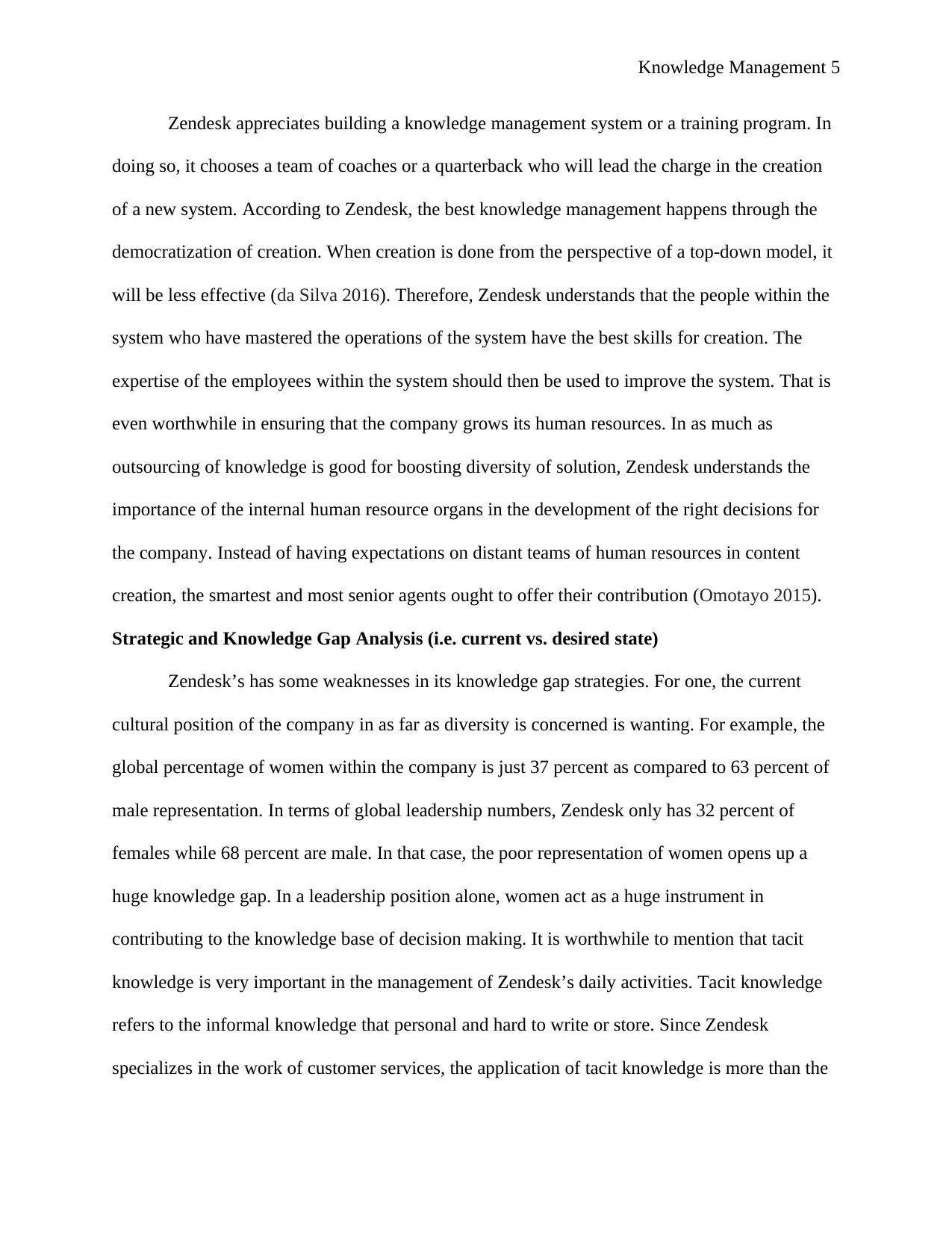
Knowledge Management 5
Zendesk appreciates building a knowledge management system or a training program. In
doing so, it chooses a team of coaches or a quarterback who will lead the charge in the creation
of a new system. According to Zendesk, the best knowledge management happens through the
democratization of creation. When creation is done from the perspective of a top-down model, it
will be less effective (da Silva 2016). Therefore, Zendesk understands that the people within the
system who have mastered the operations of the system have the best skills for creation. The
expertise of the employees within the system should then be used to improve the system. That is
even worthwhile in ensuring that the company grows its human resources. In as much as
outsourcing of knowledge is good for boosting diversity of solution, Zendesk understands the
importance of the internal human resource organs in the development of the right decisions for
the company. Instead of having expectations on distant teams of human resources in content
creation, the smartest and most senior agents ought to offer their contribution (Omotayo 2015).
Strategic and Knowledge Gap Analysis (i.e. current vs. desired state)
Zendesk’s has some weaknesses in its knowledge gap strategies. For one, the current
cultural position of the company in as far as diversity is concerned is wanting. For example, the
global percentage of women within the company is just 37 percent as compared to 63 percent of
male representation. In terms of global leadership numbers, Zendesk only has 32 percent of
females while 68 percent are male. In that case, the poor representation of women opens up a
huge knowledge gap. In a leadership position alone, women act as a huge instrument in
contributing to the knowledge base of decision making. It is worthwhile to mention that tacit
knowledge is very important in the management of Zendesk’s daily activities. Tacit knowledge
refers to the informal knowledge that personal and hard to write or store. Since Zendesk
specializes in the work of customer services, the application of tacit knowledge is more than the
Zendesk appreciates building a knowledge management system or a training program. In
doing so, it chooses a team of coaches or a quarterback who will lead the charge in the creation
of a new system. According to Zendesk, the best knowledge management happens through the
democratization of creation. When creation is done from the perspective of a top-down model, it
will be less effective (da Silva 2016). Therefore, Zendesk understands that the people within the
system who have mastered the operations of the system have the best skills for creation. The
expertise of the employees within the system should then be used to improve the system. That is
even worthwhile in ensuring that the company grows its human resources. In as much as
outsourcing of knowledge is good for boosting diversity of solution, Zendesk understands the
importance of the internal human resource organs in the development of the right decisions for
the company. Instead of having expectations on distant teams of human resources in content
creation, the smartest and most senior agents ought to offer their contribution (Omotayo 2015).
Strategic and Knowledge Gap Analysis (i.e. current vs. desired state)
Zendesk’s has some weaknesses in its knowledge gap strategies. For one, the current
cultural position of the company in as far as diversity is concerned is wanting. For example, the
global percentage of women within the company is just 37 percent as compared to 63 percent of
male representation. In terms of global leadership numbers, Zendesk only has 32 percent of
females while 68 percent are male. In that case, the poor representation of women opens up a
huge knowledge gap. In a leadership position alone, women act as a huge instrument in
contributing to the knowledge base of decision making. It is worthwhile to mention that tacit
knowledge is very important in the management of Zendesk’s daily activities. Tacit knowledge
refers to the informal knowledge that personal and hard to write or store. Since Zendesk
specializes in the work of customer services, the application of tacit knowledge is more than the
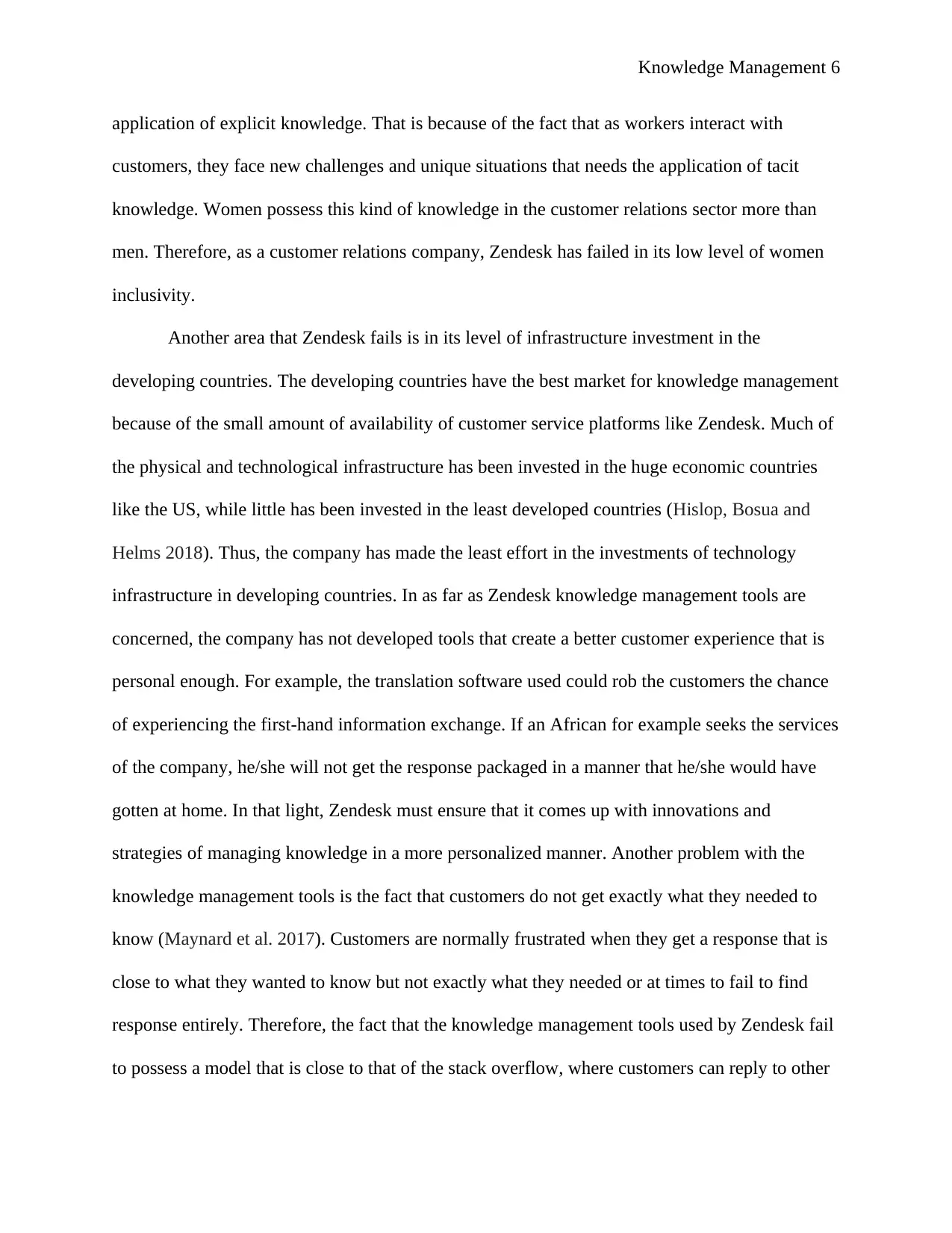
Knowledge Management 6
application of explicit knowledge. That is because of the fact that as workers interact with
customers, they face new challenges and unique situations that needs the application of tacit
knowledge. Women possess this kind of knowledge in the customer relations sector more than
men. Therefore, as a customer relations company, Zendesk has failed in its low level of women
inclusivity.
Another area that Zendesk fails is in its level of infrastructure investment in the
developing countries. The developing countries have the best market for knowledge management
because of the small amount of availability of customer service platforms like Zendesk. Much of
the physical and technological infrastructure has been invested in the huge economic countries
like the US, while little has been invested in the least developed countries (Hislop, Bosua and
Helms 2018). Thus, the company has made the least effort in the investments of technology
infrastructure in developing countries. In as far as Zendesk knowledge management tools are
concerned, the company has not developed tools that create a better customer experience that is
personal enough. For example, the translation software used could rob the customers the chance
of experiencing the first-hand information exchange. If an African for example seeks the services
of the company, he/she will not get the response packaged in a manner that he/she would have
gotten at home. In that light, Zendesk must ensure that it comes up with innovations and
strategies of managing knowledge in a more personalized manner. Another problem with the
knowledge management tools is the fact that customers do not get exactly what they needed to
know (Maynard et al. 2017). Customers are normally frustrated when they get a response that is
close to what they wanted to know but not exactly what they needed or at times to fail to find
response entirely. Therefore, the fact that the knowledge management tools used by Zendesk fail
to possess a model that is close to that of the stack overflow, where customers can reply to other
application of explicit knowledge. That is because of the fact that as workers interact with
customers, they face new challenges and unique situations that needs the application of tacit
knowledge. Women possess this kind of knowledge in the customer relations sector more than
men. Therefore, as a customer relations company, Zendesk has failed in its low level of women
inclusivity.
Another area that Zendesk fails is in its level of infrastructure investment in the
developing countries. The developing countries have the best market for knowledge management
because of the small amount of availability of customer service platforms like Zendesk. Much of
the physical and technological infrastructure has been invested in the huge economic countries
like the US, while little has been invested in the least developed countries (Hislop, Bosua and
Helms 2018). Thus, the company has made the least effort in the investments of technology
infrastructure in developing countries. In as far as Zendesk knowledge management tools are
concerned, the company has not developed tools that create a better customer experience that is
personal enough. For example, the translation software used could rob the customers the chance
of experiencing the first-hand information exchange. If an African for example seeks the services
of the company, he/she will not get the response packaged in a manner that he/she would have
gotten at home. In that light, Zendesk must ensure that it comes up with innovations and
strategies of managing knowledge in a more personalized manner. Another problem with the
knowledge management tools is the fact that customers do not get exactly what they needed to
know (Maynard et al. 2017). Customers are normally frustrated when they get a response that is
close to what they wanted to know but not exactly what they needed or at times to fail to find
response entirely. Therefore, the fact that the knowledge management tools used by Zendesk fail
to possess a model that is close to that of the stack overflow, where customers can reply to other
⊘ This is a preview!⊘
Do you want full access?
Subscribe today to unlock all pages.

Trusted by 1+ million students worldwide
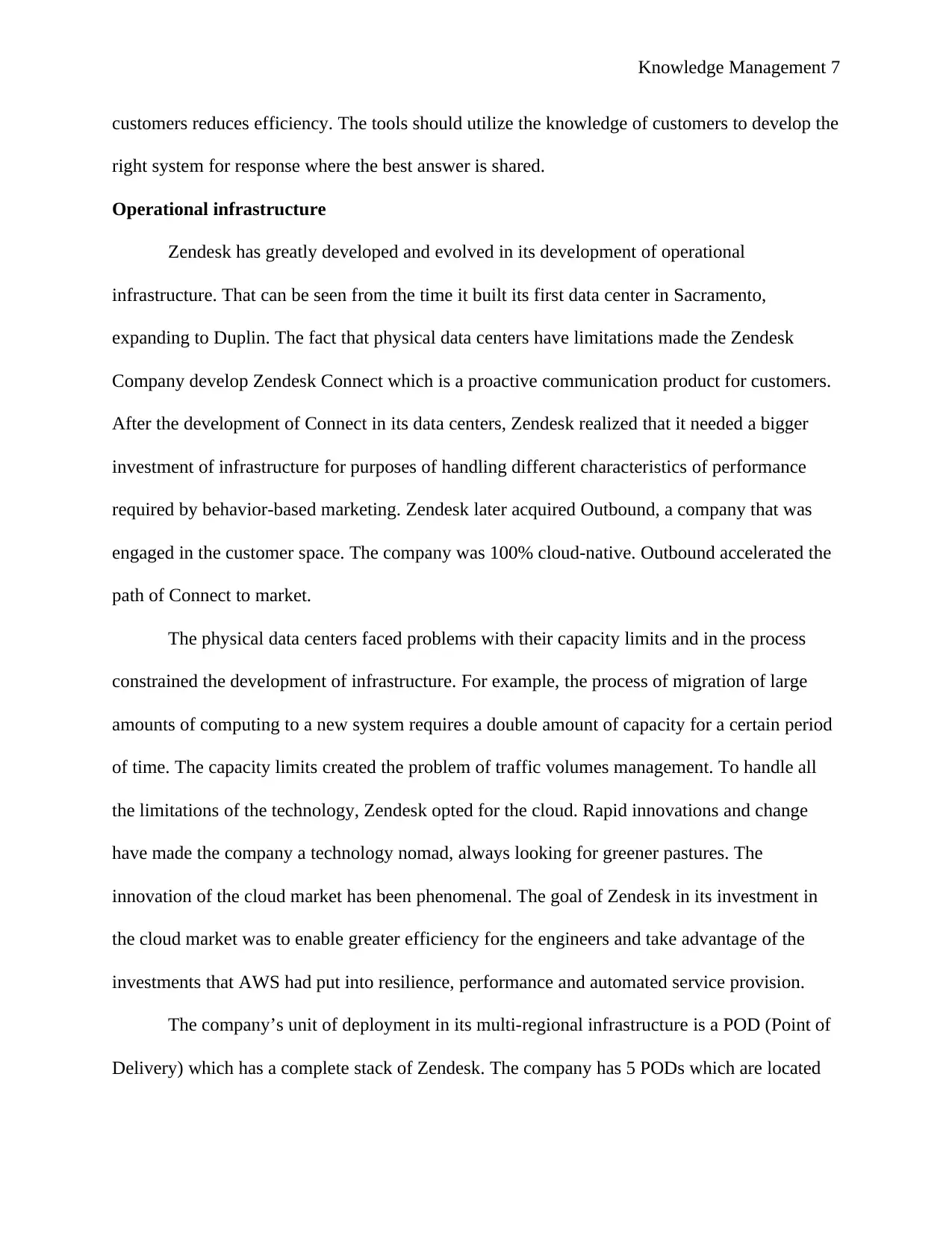
Knowledge Management 7
customers reduces efficiency. The tools should utilize the knowledge of customers to develop the
right system for response where the best answer is shared.
Operational infrastructure
Zendesk has greatly developed and evolved in its development of operational
infrastructure. That can be seen from the time it built its first data center in Sacramento,
expanding to Duplin. The fact that physical data centers have limitations made the Zendesk
Company develop Zendesk Connect which is a proactive communication product for customers.
After the development of Connect in its data centers, Zendesk realized that it needed a bigger
investment of infrastructure for purposes of handling different characteristics of performance
required by behavior-based marketing. Zendesk later acquired Outbound, a company that was
engaged in the customer space. The company was 100% cloud-native. Outbound accelerated the
path of Connect to market.
The physical data centers faced problems with their capacity limits and in the process
constrained the development of infrastructure. For example, the process of migration of large
amounts of computing to a new system requires a double amount of capacity for a certain period
of time. The capacity limits created the problem of traffic volumes management. To handle all
the limitations of the technology, Zendesk opted for the cloud. Rapid innovations and change
have made the company a technology nomad, always looking for greener pastures. The
innovation of the cloud market has been phenomenal. The goal of Zendesk in its investment in
the cloud market was to enable greater efficiency for the engineers and take advantage of the
investments that AWS had put into resilience, performance and automated service provision.
The company’s unit of deployment in its multi-regional infrastructure is a POD (Point of
Delivery) which has a complete stack of Zendesk. The company has 5 PODs which are located
customers reduces efficiency. The tools should utilize the knowledge of customers to develop the
right system for response where the best answer is shared.
Operational infrastructure
Zendesk has greatly developed and evolved in its development of operational
infrastructure. That can be seen from the time it built its first data center in Sacramento,
expanding to Duplin. The fact that physical data centers have limitations made the Zendesk
Company develop Zendesk Connect which is a proactive communication product for customers.
After the development of Connect in its data centers, Zendesk realized that it needed a bigger
investment of infrastructure for purposes of handling different characteristics of performance
required by behavior-based marketing. Zendesk later acquired Outbound, a company that was
engaged in the customer space. The company was 100% cloud-native. Outbound accelerated the
path of Connect to market.
The physical data centers faced problems with their capacity limits and in the process
constrained the development of infrastructure. For example, the process of migration of large
amounts of computing to a new system requires a double amount of capacity for a certain period
of time. The capacity limits created the problem of traffic volumes management. To handle all
the limitations of the technology, Zendesk opted for the cloud. Rapid innovations and change
have made the company a technology nomad, always looking for greener pastures. The
innovation of the cloud market has been phenomenal. The goal of Zendesk in its investment in
the cloud market was to enable greater efficiency for the engineers and take advantage of the
investments that AWS had put into resilience, performance and automated service provision.
The company’s unit of deployment in its multi-regional infrastructure is a POD (Point of
Delivery) which has a complete stack of Zendesk. The company has 5 PODs which are located
Paraphrase This Document
Need a fresh take? Get an instant paraphrase of this document with our AI Paraphraser
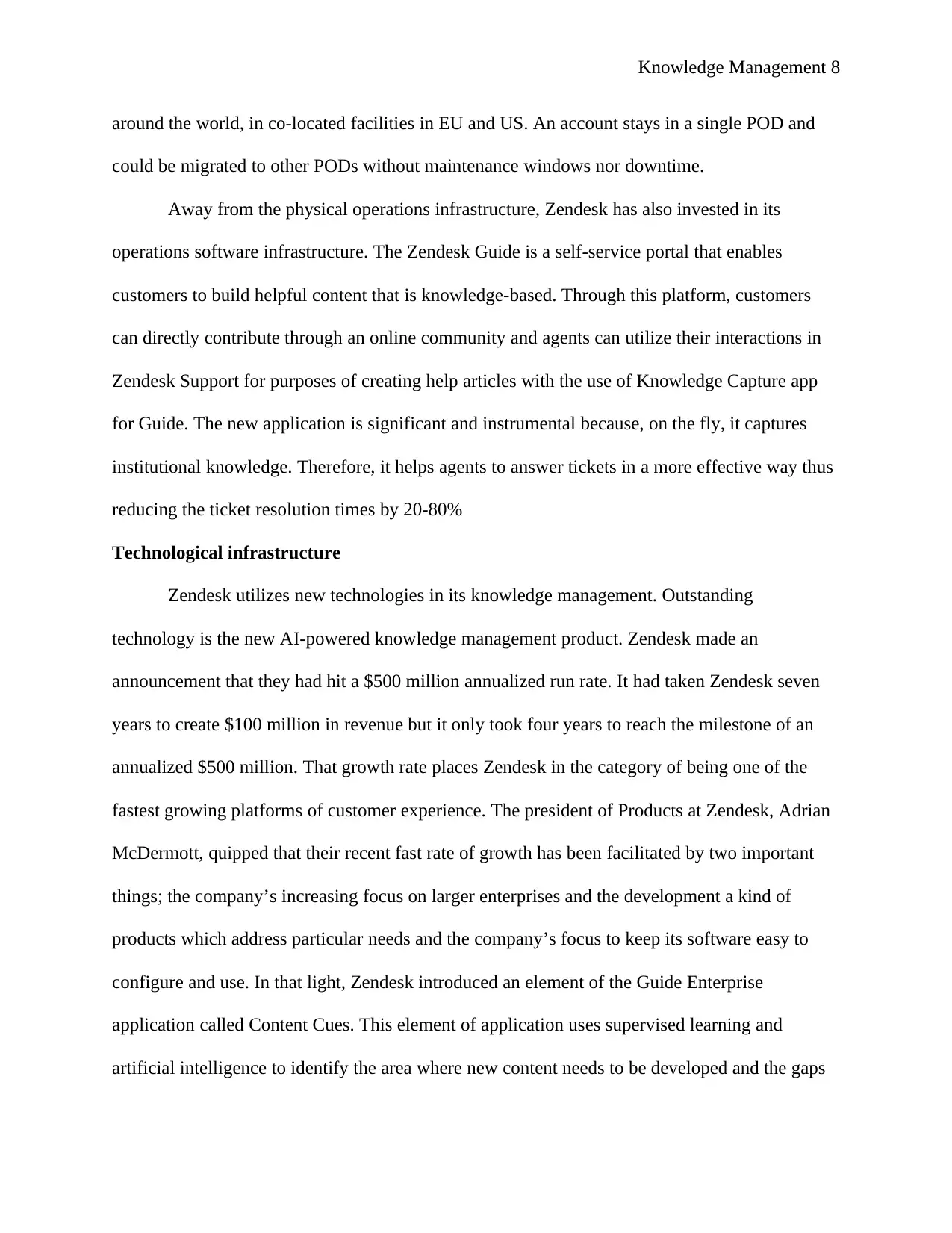
Knowledge Management 8
around the world, in co-located facilities in EU and US. An account stays in a single POD and
could be migrated to other PODs without maintenance windows nor downtime.
Away from the physical operations infrastructure, Zendesk has also invested in its
operations software infrastructure. The Zendesk Guide is a self-service portal that enables
customers to build helpful content that is knowledge-based. Through this platform, customers
can directly contribute through an online community and agents can utilize their interactions in
Zendesk Support for purposes of creating help articles with the use of Knowledge Capture app
for Guide. The new application is significant and instrumental because, on the fly, it captures
institutional knowledge. Therefore, it helps agents to answer tickets in a more effective way thus
reducing the ticket resolution times by 20-80%
Technological infrastructure
Zendesk utilizes new technologies in its knowledge management. Outstanding
technology is the new AI-powered knowledge management product. Zendesk made an
announcement that they had hit a $500 million annualized run rate. It had taken Zendesk seven
years to create $100 million in revenue but it only took four years to reach the milestone of an
annualized $500 million. That growth rate places Zendesk in the category of being one of the
fastest growing platforms of customer experience. The president of Products at Zendesk, Adrian
McDermott, quipped that their recent fast rate of growth has been facilitated by two important
things; the company’s increasing focus on larger enterprises and the development a kind of
products which address particular needs and the company’s focus to keep its software easy to
configure and use. In that light, Zendesk introduced an element of the Guide Enterprise
application called Content Cues. This element of application uses supervised learning and
artificial intelligence to identify the area where new content needs to be developed and the gaps
around the world, in co-located facilities in EU and US. An account stays in a single POD and
could be migrated to other PODs without maintenance windows nor downtime.
Away from the physical operations infrastructure, Zendesk has also invested in its
operations software infrastructure. The Zendesk Guide is a self-service portal that enables
customers to build helpful content that is knowledge-based. Through this platform, customers
can directly contribute through an online community and agents can utilize their interactions in
Zendesk Support for purposes of creating help articles with the use of Knowledge Capture app
for Guide. The new application is significant and instrumental because, on the fly, it captures
institutional knowledge. Therefore, it helps agents to answer tickets in a more effective way thus
reducing the ticket resolution times by 20-80%
Technological infrastructure
Zendesk utilizes new technologies in its knowledge management. Outstanding
technology is the new AI-powered knowledge management product. Zendesk made an
announcement that they had hit a $500 million annualized run rate. It had taken Zendesk seven
years to create $100 million in revenue but it only took four years to reach the milestone of an
annualized $500 million. That growth rate places Zendesk in the category of being one of the
fastest growing platforms of customer experience. The president of Products at Zendesk, Adrian
McDermott, quipped that their recent fast rate of growth has been facilitated by two important
things; the company’s increasing focus on larger enterprises and the development a kind of
products which address particular needs and the company’s focus to keep its software easy to
configure and use. In that light, Zendesk introduced an element of the Guide Enterprise
application called Content Cues. This element of application uses supervised learning and
artificial intelligence to identify the area where new content needs to be developed and the gaps
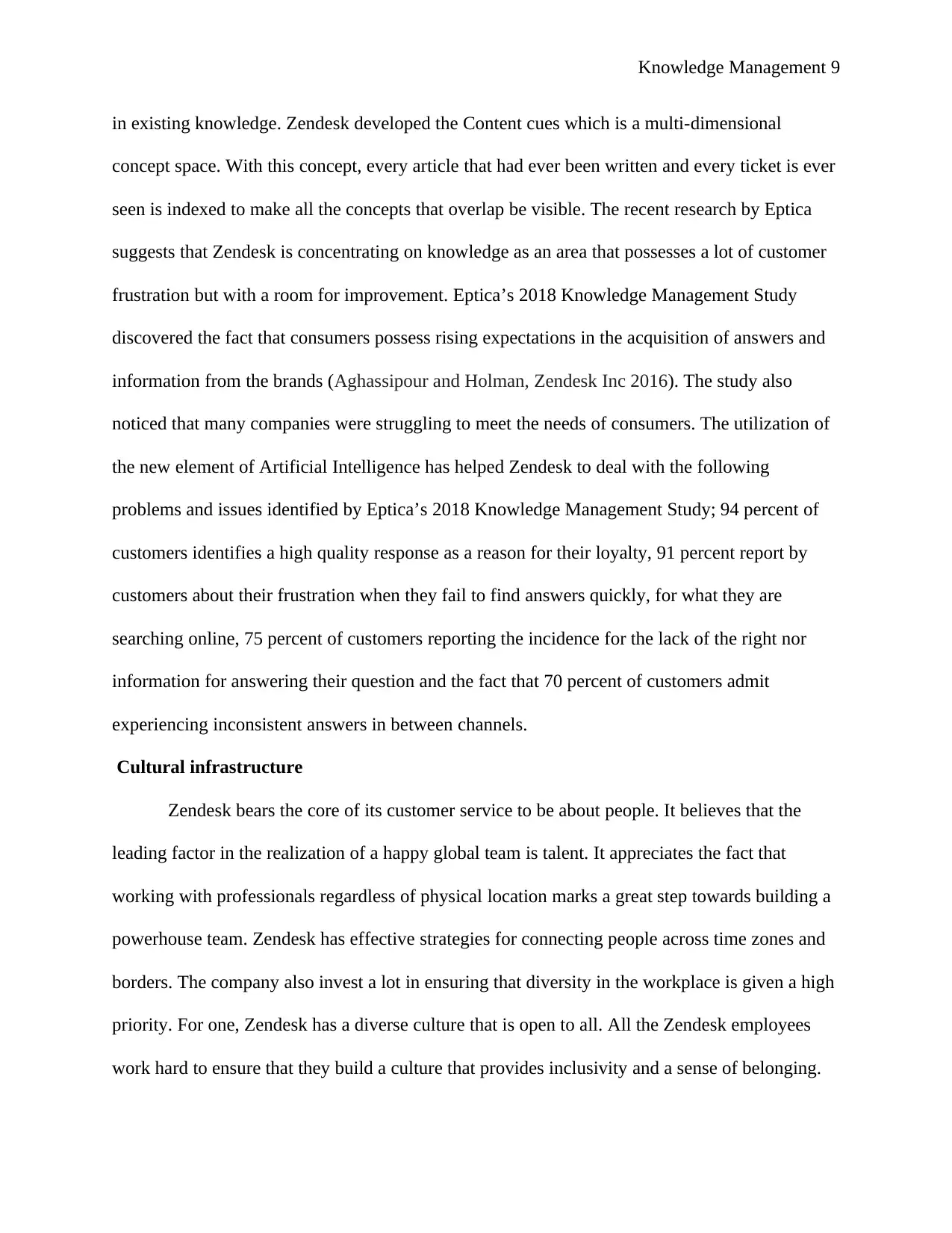
Knowledge Management 9
in existing knowledge. Zendesk developed the Content cues which is a multi-dimensional
concept space. With this concept, every article that had ever been written and every ticket is ever
seen is indexed to make all the concepts that overlap be visible. The recent research by Eptica
suggests that Zendesk is concentrating on knowledge as an area that possesses a lot of customer
frustration but with a room for improvement. Eptica’s 2018 Knowledge Management Study
discovered the fact that consumers possess rising expectations in the acquisition of answers and
information from the brands (Aghassipour and Holman, Zendesk Inc 2016). The study also
noticed that many companies were struggling to meet the needs of consumers. The utilization of
the new element of Artificial Intelligence has helped Zendesk to deal with the following
problems and issues identified by Eptica’s 2018 Knowledge Management Study; 94 percent of
customers identifies a high quality response as a reason for their loyalty, 91 percent report by
customers about their frustration when they fail to find answers quickly, for what they are
searching online, 75 percent of customers reporting the incidence for the lack of the right nor
information for answering their question and the fact that 70 percent of customers admit
experiencing inconsistent answers in between channels.
Cultural infrastructure
Zendesk bears the core of its customer service to be about people. It believes that the
leading factor in the realization of a happy global team is talent. It appreciates the fact that
working with professionals regardless of physical location marks a great step towards building a
powerhouse team. Zendesk has effective strategies for connecting people across time zones and
borders. The company also invest a lot in ensuring that diversity in the workplace is given a high
priority. For one, Zendesk has a diverse culture that is open to all. All the Zendesk employees
work hard to ensure that they build a culture that provides inclusivity and a sense of belonging.
in existing knowledge. Zendesk developed the Content cues which is a multi-dimensional
concept space. With this concept, every article that had ever been written and every ticket is ever
seen is indexed to make all the concepts that overlap be visible. The recent research by Eptica
suggests that Zendesk is concentrating on knowledge as an area that possesses a lot of customer
frustration but with a room for improvement. Eptica’s 2018 Knowledge Management Study
discovered the fact that consumers possess rising expectations in the acquisition of answers and
information from the brands (Aghassipour and Holman, Zendesk Inc 2016). The study also
noticed that many companies were struggling to meet the needs of consumers. The utilization of
the new element of Artificial Intelligence has helped Zendesk to deal with the following
problems and issues identified by Eptica’s 2018 Knowledge Management Study; 94 percent of
customers identifies a high quality response as a reason for their loyalty, 91 percent report by
customers about their frustration when they fail to find answers quickly, for what they are
searching online, 75 percent of customers reporting the incidence for the lack of the right nor
information for answering their question and the fact that 70 percent of customers admit
experiencing inconsistent answers in between channels.
Cultural infrastructure
Zendesk bears the core of its customer service to be about people. It believes that the
leading factor in the realization of a happy global team is talent. It appreciates the fact that
working with professionals regardless of physical location marks a great step towards building a
powerhouse team. Zendesk has effective strategies for connecting people across time zones and
borders. The company also invest a lot in ensuring that diversity in the workplace is given a high
priority. For one, Zendesk has a diverse culture that is open to all. All the Zendesk employees
work hard to ensure that they build a culture that provides inclusivity and a sense of belonging.
⊘ This is a preview!⊘
Do you want full access?
Subscribe today to unlock all pages.

Trusted by 1+ million students worldwide
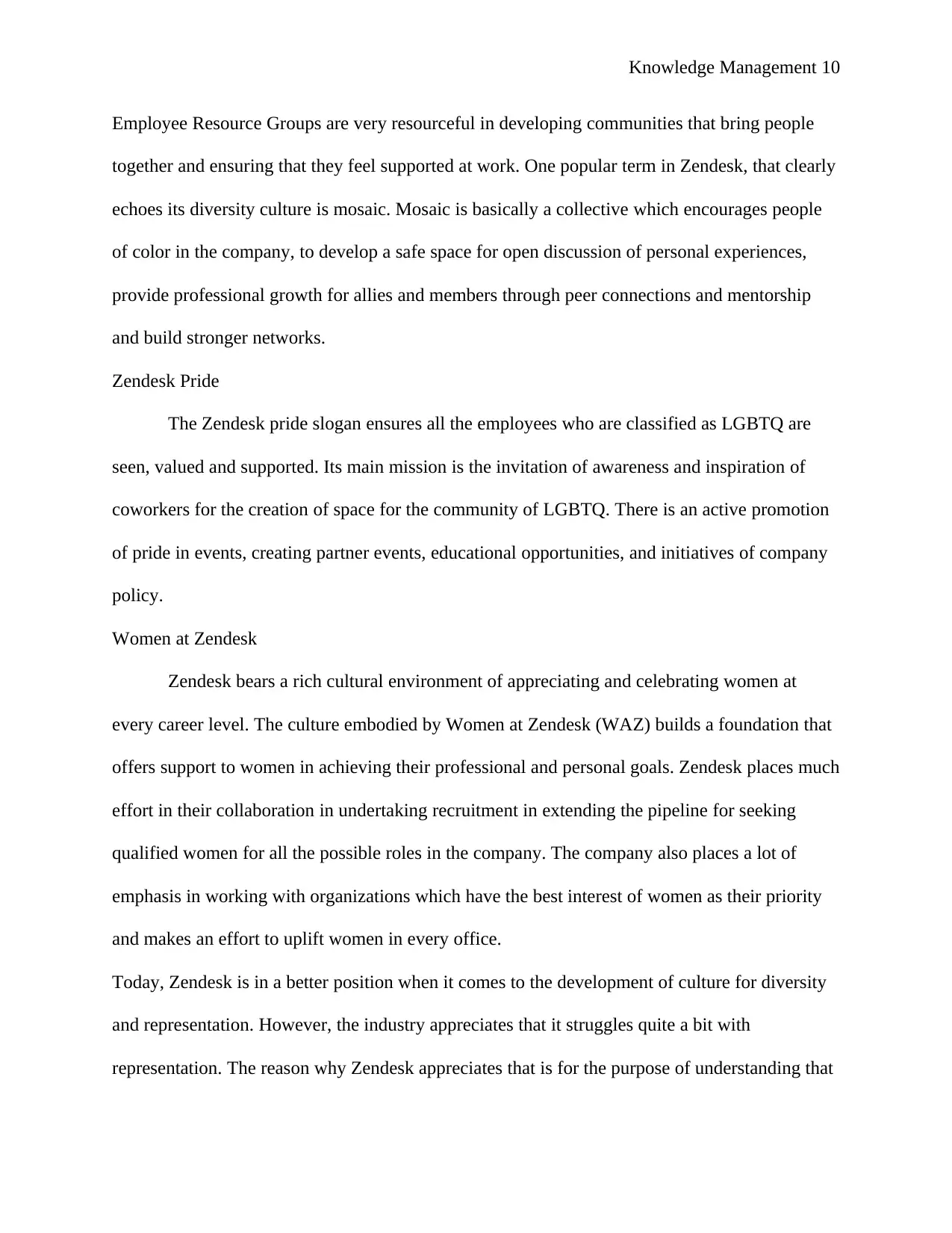
Knowledge Management 10
Employee Resource Groups are very resourceful in developing communities that bring people
together and ensuring that they feel supported at work. One popular term in Zendesk, that clearly
echoes its diversity culture is mosaic. Mosaic is basically a collective which encourages people
of color in the company, to develop a safe space for open discussion of personal experiences,
provide professional growth for allies and members through peer connections and mentorship
and build stronger networks.
Zendesk Pride
The Zendesk pride slogan ensures all the employees who are classified as LGBTQ are
seen, valued and supported. Its main mission is the invitation of awareness and inspiration of
coworkers for the creation of space for the community of LGBTQ. There is an active promotion
of pride in events, creating partner events, educational opportunities, and initiatives of company
policy.
Women at Zendesk
Zendesk bears a rich cultural environment of appreciating and celebrating women at
every career level. The culture embodied by Women at Zendesk (WAZ) builds a foundation that
offers support to women in achieving their professional and personal goals. Zendesk places much
effort in their collaboration in undertaking recruitment in extending the pipeline for seeking
qualified women for all the possible roles in the company. The company also places a lot of
emphasis in working with organizations which have the best interest of women as their priority
and makes an effort to uplift women in every office.
Today, Zendesk is in a better position when it comes to the development of culture for diversity
and representation. However, the industry appreciates that it struggles quite a bit with
representation. The reason why Zendesk appreciates that is for the purpose of understanding that
Employee Resource Groups are very resourceful in developing communities that bring people
together and ensuring that they feel supported at work. One popular term in Zendesk, that clearly
echoes its diversity culture is mosaic. Mosaic is basically a collective which encourages people
of color in the company, to develop a safe space for open discussion of personal experiences,
provide professional growth for allies and members through peer connections and mentorship
and build stronger networks.
Zendesk Pride
The Zendesk pride slogan ensures all the employees who are classified as LGBTQ are
seen, valued and supported. Its main mission is the invitation of awareness and inspiration of
coworkers for the creation of space for the community of LGBTQ. There is an active promotion
of pride in events, creating partner events, educational opportunities, and initiatives of company
policy.
Women at Zendesk
Zendesk bears a rich cultural environment of appreciating and celebrating women at
every career level. The culture embodied by Women at Zendesk (WAZ) builds a foundation that
offers support to women in achieving their professional and personal goals. Zendesk places much
effort in their collaboration in undertaking recruitment in extending the pipeline for seeking
qualified women for all the possible roles in the company. The company also places a lot of
emphasis in working with organizations which have the best interest of women as their priority
and makes an effort to uplift women in every office.
Today, Zendesk is in a better position when it comes to the development of culture for diversity
and representation. However, the industry appreciates that it struggles quite a bit with
representation. The reason why Zendesk appreciates that is for the purpose of understanding that
Paraphrase This Document
Need a fresh take? Get an instant paraphrase of this document with our AI Paraphraser
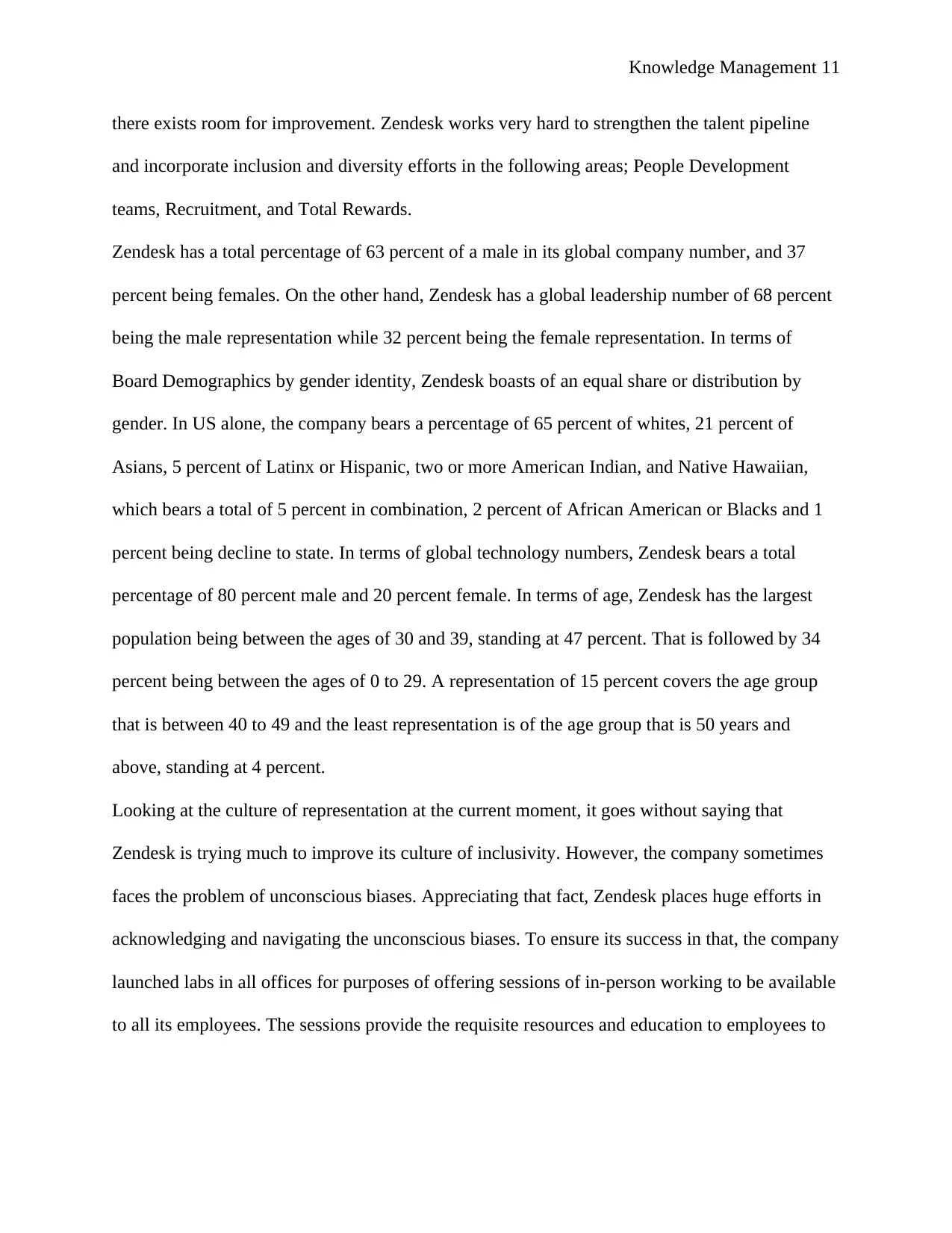
Knowledge Management 11
there exists room for improvement. Zendesk works very hard to strengthen the talent pipeline
and incorporate inclusion and diversity efforts in the following areas; People Development
teams, Recruitment, and Total Rewards.
Zendesk has a total percentage of 63 percent of a male in its global company number, and 37
percent being females. On the other hand, Zendesk has a global leadership number of 68 percent
being the male representation while 32 percent being the female representation. In terms of
Board Demographics by gender identity, Zendesk boasts of an equal share or distribution by
gender. In US alone, the company bears a percentage of 65 percent of whites, 21 percent of
Asians, 5 percent of Latinx or Hispanic, two or more American Indian, and Native Hawaiian,
which bears a total of 5 percent in combination, 2 percent of African American or Blacks and 1
percent being decline to state. In terms of global technology numbers, Zendesk bears a total
percentage of 80 percent male and 20 percent female. In terms of age, Zendesk has the largest
population being between the ages of 30 and 39, standing at 47 percent. That is followed by 34
percent being between the ages of 0 to 29. A representation of 15 percent covers the age group
that is between 40 to 49 and the least representation is of the age group that is 50 years and
above, standing at 4 percent.
Looking at the culture of representation at the current moment, it goes without saying that
Zendesk is trying much to improve its culture of inclusivity. However, the company sometimes
faces the problem of unconscious biases. Appreciating that fact, Zendesk places huge efforts in
acknowledging and navigating the unconscious biases. To ensure its success in that, the company
launched labs in all offices for purposes of offering sessions of in-person working to be available
to all its employees. The sessions provide the requisite resources and education to employees to
there exists room for improvement. Zendesk works very hard to strengthen the talent pipeline
and incorporate inclusion and diversity efforts in the following areas; People Development
teams, Recruitment, and Total Rewards.
Zendesk has a total percentage of 63 percent of a male in its global company number, and 37
percent being females. On the other hand, Zendesk has a global leadership number of 68 percent
being the male representation while 32 percent being the female representation. In terms of
Board Demographics by gender identity, Zendesk boasts of an equal share or distribution by
gender. In US alone, the company bears a percentage of 65 percent of whites, 21 percent of
Asians, 5 percent of Latinx or Hispanic, two or more American Indian, and Native Hawaiian,
which bears a total of 5 percent in combination, 2 percent of African American or Blacks and 1
percent being decline to state. In terms of global technology numbers, Zendesk bears a total
percentage of 80 percent male and 20 percent female. In terms of age, Zendesk has the largest
population being between the ages of 30 and 39, standing at 47 percent. That is followed by 34
percent being between the ages of 0 to 29. A representation of 15 percent covers the age group
that is between 40 to 49 and the least representation is of the age group that is 50 years and
above, standing at 4 percent.
Looking at the culture of representation at the current moment, it goes without saying that
Zendesk is trying much to improve its culture of inclusivity. However, the company sometimes
faces the problem of unconscious biases. Appreciating that fact, Zendesk places huge efforts in
acknowledging and navigating the unconscious biases. To ensure its success in that, the company
launched labs in all offices for purposes of offering sessions of in-person working to be available
to all its employees. The sessions provide the requisite resources and education to employees to
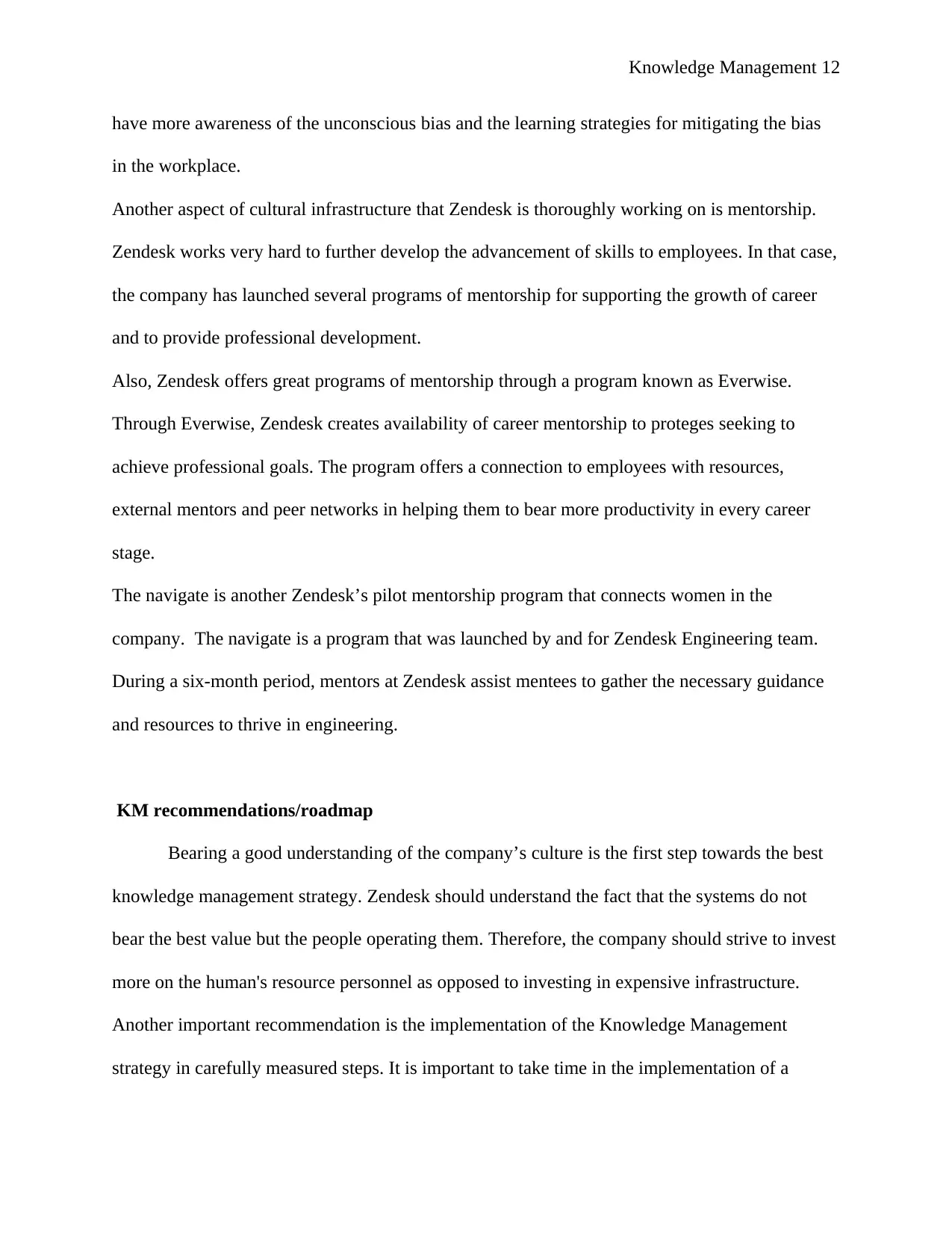
Knowledge Management 12
have more awareness of the unconscious bias and the learning strategies for mitigating the bias
in the workplace.
Another aspect of cultural infrastructure that Zendesk is thoroughly working on is mentorship.
Zendesk works very hard to further develop the advancement of skills to employees. In that case,
the company has launched several programs of mentorship for supporting the growth of career
and to provide professional development.
Also, Zendesk offers great programs of mentorship through a program known as Everwise.
Through Everwise, Zendesk creates availability of career mentorship to proteges seeking to
achieve professional goals. The program offers a connection to employees with resources,
external mentors and peer networks in helping them to bear more productivity in every career
stage.
The navigate is another Zendesk’s pilot mentorship program that connects women in the
company. The navigate is a program that was launched by and for Zendesk Engineering team.
During a six-month period, mentors at Zendesk assist mentees to gather the necessary guidance
and resources to thrive in engineering.
KM recommendations/roadmap
Bearing a good understanding of the company’s culture is the first step towards the best
knowledge management strategy. Zendesk should understand the fact that the systems do not
bear the best value but the people operating them. Therefore, the company should strive to invest
more on the human's resource personnel as opposed to investing in expensive infrastructure.
Another important recommendation is the implementation of the Knowledge Management
strategy in carefully measured steps. It is important to take time in the implementation of a
have more awareness of the unconscious bias and the learning strategies for mitigating the bias
in the workplace.
Another aspect of cultural infrastructure that Zendesk is thoroughly working on is mentorship.
Zendesk works very hard to further develop the advancement of skills to employees. In that case,
the company has launched several programs of mentorship for supporting the growth of career
and to provide professional development.
Also, Zendesk offers great programs of mentorship through a program known as Everwise.
Through Everwise, Zendesk creates availability of career mentorship to proteges seeking to
achieve professional goals. The program offers a connection to employees with resources,
external mentors and peer networks in helping them to bear more productivity in every career
stage.
The navigate is another Zendesk’s pilot mentorship program that connects women in the
company. The navigate is a program that was launched by and for Zendesk Engineering team.
During a six-month period, mentors at Zendesk assist mentees to gather the necessary guidance
and resources to thrive in engineering.
KM recommendations/roadmap
Bearing a good understanding of the company’s culture is the first step towards the best
knowledge management strategy. Zendesk should understand the fact that the systems do not
bear the best value but the people operating them. Therefore, the company should strive to invest
more on the human's resource personnel as opposed to investing in expensive infrastructure.
Another important recommendation is the implementation of the Knowledge Management
strategy in carefully measured steps. It is important to take time in the implementation of a
⊘ This is a preview!⊘
Do you want full access?
Subscribe today to unlock all pages.

Trusted by 1+ million students worldwide
1 out of 15
Related Documents
Your All-in-One AI-Powered Toolkit for Academic Success.
+13062052269
info@desklib.com
Available 24*7 on WhatsApp / Email
![[object Object]](/_next/static/media/star-bottom.7253800d.svg)
Unlock your academic potential
Copyright © 2020–2025 A2Z Services. All Rights Reserved. Developed and managed by ZUCOL.





